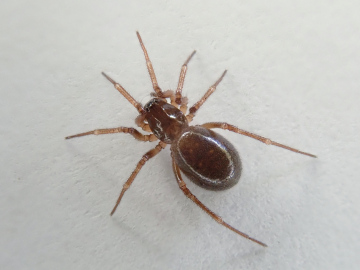Notes on Halorates reprobus

A Note on the Habitat and Life Cycle of the Sea-shore Spider Halorates reprobus (O.P.-Cambridge, 1879) (Araneae, Linyphiidae) in Belgium by H. Vanuytven
From The Newsletter No. 66 March 1993
In Belgium, Halorates reprobus (O.P.-Cambridge, 1879) is a very rare species. It had, until recently, been found only once, in the lower zone of a saltmarsh at the mouth of the river Ijzer (Decleer & Bosnians, 1989). These authors gave a distribution map of the species and a description of its habitat. According to them, data on the life cycle are very scarce; collecting data show that adults were captured in the period April-October. Locket & Millidge (1953) stated that adults can be found during most of the year, and Heimer & Nentwig (1991) indicated 'ganzjahrig'. In September 1991, the spider was found along the shore of the river Scheldt only a few kilometres downstream from the city of Antwerp. This city is about 100 km from the sea, but the difference in height between low and high tide is still several metres. To my knowledge, this is the first record at such a distance from the sea.
At this place the dike is split into two parts. The first part, which is quite steep, is made up of blocks of concrete, then there is a horizontal strip of mud, about ten metres wide, leading to the second and highest part of the dike. At high tide, salt water floats up to and even over the horizontal strip of mud. Some blocks of concrete lie in the mud. These blocks have very irregular surfaces, with numerous small holes. It is on the underside of these blocks that a large population of Halorates reprobus was discovered. The blocks are not covered every day; an onshore wind or waves from passing boats are needed for the water to come high enough. The species also occurs at another site, where blocks lie at the foot of the lowest part of the dike. In order to follow the life cycle of the species, the site was visited at regular intervals throughout one year. Males and females were found throughout the year, and surprisingly enough, their number did not seem to change. Egg cocoons and juveniles also were observed on nearly every visit. Because the spiders were disturbed by turning the blocks, mating could not be observed. But on 12th November 1991, several males and females were found so close together that they must have been mating.
It can be concluded that adults are present throughout the year, that reproduction continues throughout the year and that copulation takes place in the autumn. I am grateful to R. Bosnians for his most helpful remarks.
References
Decleer. K. & Bosnians. R. (1989) Distribution and ecological aspects
of four rare wetland spiders, recently reported from Belgium.
Bull. Br. arachnol. Soc. 8: 80-88.
Heimer. S. & Nentwig, W. (1991) Spinnen Mitteleuropas. Verlag Paul
Parey, Berlin and Hamburg.
Locket. G.H. & Millidge, A.F. (1953) British Spiders II. Ray Society.
London.
Vekestraat 1. 2000 ANTWERPEN. Belgium
Added by John Partridge at 20:43 on Fri 24th Feb 2012.
Return to Summary for Halorates reprobus